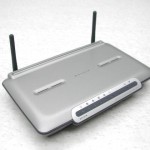 I should actually call this post ‘things I should have known but thought I knew better!’
I should actually call this post ‘things I should have known but thought I knew better!’
In recent weeks we’ve had a few ups and downs with the Broadband connection, culminating in a call to BT’s technical support line. Of course, when I did call them the line started behaving itself again during the call, so maybe the threat of technical intervention did the trick. However, here are some observations and tips on Broadband that you may find valuable. Most of these apply to any Broadband supplier, but one is BT Business Broadband specific.
Is that internal phone extension really necessary?
Due to a lack of power sockets (or even sensible places to put a power socket) and places to put routers near the main BT phone socket, for years we have had the router in an upstairs room, connected to the BT socket via an extension cable. During testing I bought the router down to the phone socket and jury-rigged power to it, and was rewarded by an increase in speed of over 1Mb/s on the downstream connection, and lower noise levels on the line. So, if you can manage it, try and plumb the router in as close as is practicable to the point where the land-line enters the house.
Snow and ice are not nice!
If you have a phone line of, shall we say, a certain age, then the chances are that the insulation has started to perish and water ingress is a possibility. If this happens in the winter, and the water freezes, any cracks are often widened thus making it easier for more water to enter. Snow and ice on phone lines can cause signal degradation by bridging the gap between cable and nearby earthed objects – trees, etc. – and if there are insulation problems then you can expect a degraded signal to noise ratio, which will lead to a reduction in performance.
Listen in!
Assuming correctly fitted Line filters, you will not hear any significant noise in a phone handset when ADSL is operating. If you hear a noticeable hissing noise then it can indicate a leaky ADSL Line Filter. If you hear regular crackles or other noises on the line, then these will cause degradation of your signal. Plug your phone in to the phone socket where it enters the house, with no other extensions plugged in. If the crackles continue and are regular, then it’s almost certainly worth a call to your phone company. Note that occasional noise is inevitable – electrical devices turning on and off, nearby thunder storms, etc. all cause this sort of interference and there is nothing that can be realistically done by the phone company about them. Your phone company may charge for the survey if they find nothing wrong.
Cycle that router!
If you have had a poor broadband connection, and battled on with it for a few hours, then the router may well have adapted itself to the lower rate. Turn the router off, leave it off for a few minutes, then turn it back on again. I did this recently and was rewarded by a doubling of speed.
Find a test account
Most ISPs have test accounts that will allow you to determine whether the problem is it your end or the exchange end. For BT, this is bt_test@startup_domain, with any password. Enter this in to your login credentials on your router and try to connect to Broadband. If your installation is OK, you will connect but the only web site available to you will be a BT holding page, that tells you that you’ve logged in under a test account. Get this far and any other problems you’re having are either on your PC or out beyond the immediate BT exchange connection.
Get a second ADSL Modem
I have an old ‘Frog’ ADSL modem which still works. I have installed teh software for it on to my Netbook, and so I have a second system to connect to the Internet with over my phone line. (I also have an old ‘dial up’ modem but that’s really getting desperate!) This proved to be very useful recently when I accidentally nuked the main router settings. These devices are pretty cheap to get hold of and can be useful in these circumstances.
Get your ISP’s tech support numbers….NOW!
Don’t wait until things are broken to realise that you don’t have the tech support numbers and that you need to go to their website to get them. In a similar vein, ensure you have login credentials, etc. available locally and not in some online depository.
